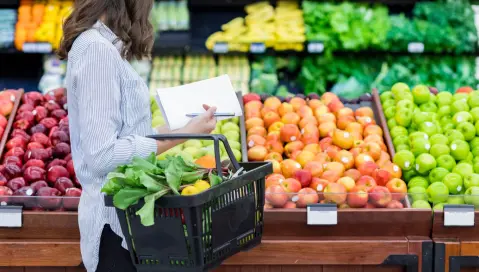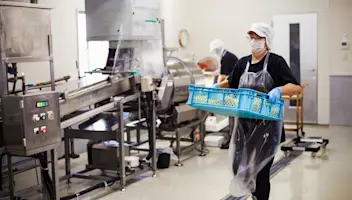In diesem Beitrag vorgestellt
The Future of the Food Industry: Unveiling Insights From Aptean's Food and Beverage 2024 Trends Report
The Future of the Food Industry: Unveiling Insights From Aptean's Food and Beverage 2024 Trends Report
31 Okt 2023
Aptean Staff Writer
In the dynamic world of food and beverage, innovation, scalability and strategic decision-making are vital ingredients for success. As an industry professional, you know this reality well, and you must always have your finger on the pulse of the market to stay ahead of the competition.
To uncover insights—that leaders like you need to drive growth—Aptean conducted an extensive survey in collaboration with B2B International to get a read on North America's thriving food processing, manufacturing and distribution sector.
The result is the eagerly awaited Aptean Food and Beverage 2024 Trends and Outlook for North America report, which unveiled major industry trends that impacted businesses throughout 2023, from supply chain challenges to the growing importance of technology.
In this post, we’ll whet your appetite for the full report by sharing the six key findings from the research. By using these insights to inform your approach for the future, you can help maximize the chances your brand will continue to thrive going forward.
Trend No. 1: Food and Beverage Companies Are in a Growth Mindset
The food and beverage industry has faced numerous challenges in the past year, including rising inflation, higher operating costs and fluctuating material availability. Despite these difficulties, most companies remain confident about their performance in 2023 and are optimistic about their growth prospects in 2024.
According to the report, 79% of food processors, manufacturers and distributors expect to generate more revenue in 2023 than the previous year, while 77% anticipate an increase in profits.
As the industry prepares for 2024, most companies are adopting a growth mindset and are determined to adapt to market conditions to avoid stagnation.
of food processors, manufacturers and distributors expect to generate more revenue in 2023 than the previous year.
Trend No. 2: Automation Is Critical To Tackling Growth Barriers
The food and beverage industry is undergoing a digital transformation, with 90% of companies surveyed in the process of adopting technology. Businesses that have embraced automation have seen 1.3% higher revenue growth compared to those relying on manual processes.
In particular, industry-specific solutions like enterprise asset management (EAM) and electronic data interchange (EDI) software have delivered up to 45% higher revenue growth.
And many businesses are planning investments in areas such as freight management, route planning, asset management and product lifecycle management (PLM), to drive automation and boost efficiency across a variety of departments.
It’s worth noting that companies using industry-specific software have experienced higher revenue growth compared to their peers using generic solutions—and cloud-based solutions are gaining traction.
What’s more, the correlation between digital maturity and financial performance highlights the importance of strategic technology investments. In short, delaying your digital transformation could result in falling behind market leaders.
Trend No. 3: The Automated Environment Is Driving Uptake of Business Intelligence Tools and Interest in Artificial Intelligence
In 2024, food and beverage companies are looking beyond optimizing individual processes and instead embracing the holistic benefits of digital transformation.
With the use of digital systems generating more data than ever, industry leaders want to leverage this information for smarter decision-making. That said, one in four organizations struggle to obtain and analyze data on business performance efficiently.
To address this, 41% of companies plan to invest in business intelligence (BI) tools over the next year.
Take Green Valley Pecan for example, a grower and processor that integrated BI tools with its Aptean Food & Beverage ERP software, enabling the application of data-driven insights to drive reliable production and healthy profit margins.
It’s clear that artificial intelligence (AI) can give your food and beverage organization an edge. But, with the data showing that many businesses don’t yet have clear plans to support their intent, it will be crucial to form a robust plan for implementation.
Reviewing existing technology stacks, establishing clear goals for BI and AI and ensuring integration will be critical steps in shifting to data-driven decision-making. However, complex system integration remains a barrier, so you may want to consider seeking a single vendor for multiple solutions to simplify the process.
Industry-specific solutions like EAM and EDI software have delivered up to 45% higher revenue growth.
Trend No. 4: Supply Chain Resilience Is the Top Priority for 2024
In 2023, supply chains faced disruptions due to material shortages, geopolitical conflicts, extreme weather conditions and other challenging circumstances.
As such, improving supply chain resilience will be the top priority for food companies in 2024, with a focus on strengthening networks. Many organizations added new suppliers to their portfolio, and some larger brands invested directly in agriculture to increase stability.
Internal optimization, such as improving production scheduling and enhancing forecasting capabilities, drove higher revenue for companies despite supply chain struggles. In addition, automation will continue to play a critical role in improving supply chain logistics, even though the report revealed that a significant portion of food processors, manufacturers and distributors still rely on manual processes.
Digitally transforming the supply chain through technology adoption will enhance visibility and drive efficiency. This is reflected in the fact that 36% of the companies surveyed want to use technology to optimize supply chain visibility, while 32% want to increase quality checks.
Trend No. 5: Economic Goals Are Creating a Business Case for Sustainability Programs
In this year’s report, sustainability was cited as a top priority for 84% of food processors, manufacturers and distributors. Interestingly, the main motivation behind these sustainability initiatives is not social responsibility, but the desire to become more efficient.
In fact, prioritizing sustainability has proven to deliver economic improvements, with more sustainable companies reporting higher revenue and profit growth.
That’s due to the fact that developing a robust sustainability strategy allows food and beverage firms to cut costs and reduce their carbon footprint through a single program.
By aligning environmental programs with strategic business objectives, you’re able to make smarter decisions in deploying technologies that drive sustainable growth, appealing to both internal stakeholders and consumers who are willing to pay more for sustainable products.
of companies plan to invest in business intelligence (BI) tools over the next year.
Trend No. 6: Food and Beverage Companies Are Already Building Their Future
The top priority for North American food and beverage companies between now and 2027 is attracting the best people and building high-performing teams. The report highlights that skills and labor shortages have prompted immediate investment in the workforce.
However, forward-thinking organizations are also focused on creating an infrastructure that aligns with the needs of the future workforce.
As Baby Boomers retire, market leaders have the opportunity to transform processes and centrally manage data to appeal to Gen Z employees. This "changing of the guard" presents an opportunity for your business to assess future workforce needs and align them with your digital transformation strategy.
This process will require determining which roles can be automated, where skill gaps exist and what your employees expect. It will be a serious strategic undertaking, and all departments of your organization should be involved.
Future-Proofing Your Business With Aptean Solutions
By applying a growth mindset and investing in technologies that enhance critical efforts like supply chain visibility, manufacturing operations and workforce optimization, food and beverage companies can drive significant enhancements over the next five years.
When it comes to choosing a technology provider, Aptean should be at the top of your list, as we strive to act as a partner for each of our customers. Our dedicated professionals also know the food and beverage industry inside and out, which has afforded them in-depth expertise and knowledge of best practices.
What’s more, we offer a full range of food and beverage-specific solutions, including our award-winning ERP software, as well as overall equipment effectiveness (OEE), enterprise asset management (EAM) and product lifecycle management (PLM) systems.
Download the full Aptean Food and Beverage 2024 Trends and Outlook for North America and discover how Aptean food and beverage solutions can accelerate business growth and help you succeed in a dynamic marketplace.
Finally, if you prefer to discuss your solution needs with one of our experts, reach out to us today and unlock the full potential of your food and beverage company with Aptean's industry-specific software solutions.
Related Articles





How To Thrive During Food and Beverage Market Turbulence
Prioritizing modernization, optimization and a sound strategy is necessary for success in the food and beverage industry. Increase operational agility in a continually changing (and often unpredictable) manufacturing landscape.




